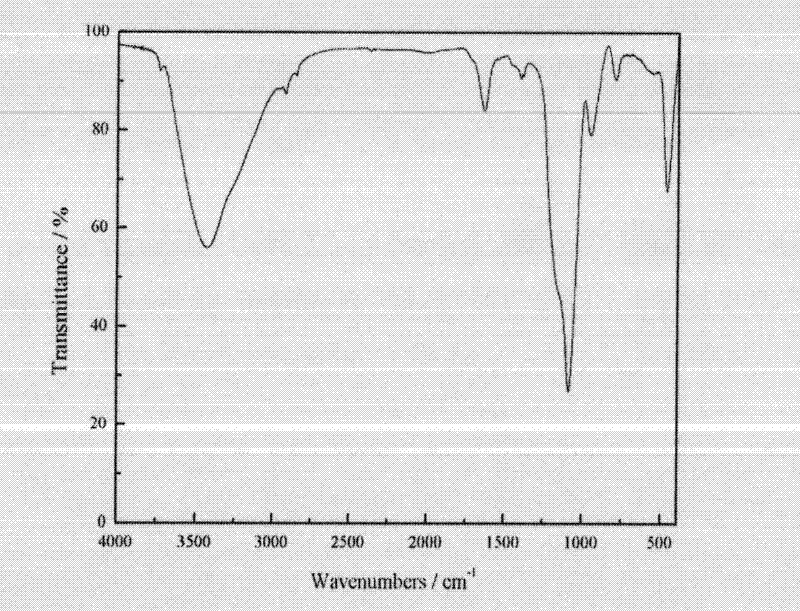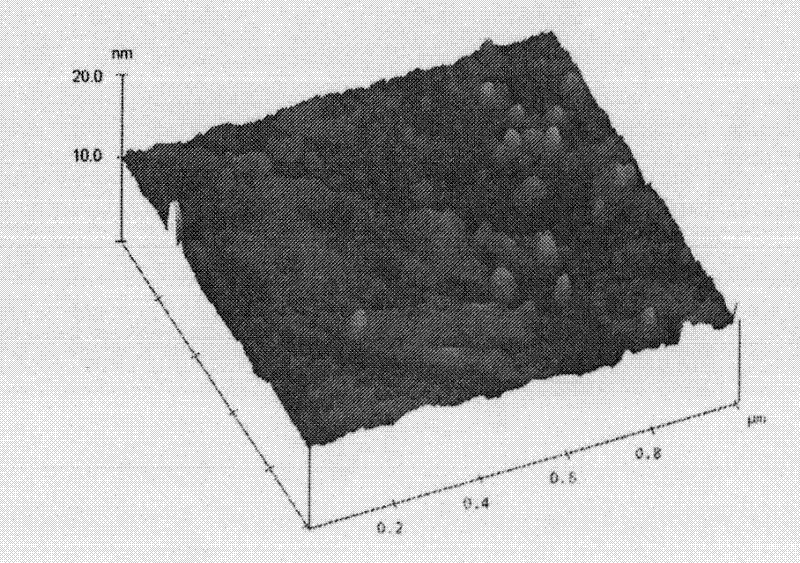Method for preparing self-cleaning protective film of solar cell
A solar cell and self-cleaning technology, which is applied in the field of preparation of solar cell self-cleaning protective film, can solve problems such as solar cells are easily broken and easily corroded, achieve low cost, increase transmittance, and reduce transmittance decline Effect
- Summary
- Abstract
- Description
- Claims
- Application Information
AI Technical Summary
Problems solved by technology
Method used
Image
Examples
Embodiment 1
[0029] Use 12ml of tetraethyl orthosilicate, 40ml of ethanol and 6ml of water as raw materials, hydrochloric acid as a catalyst (3 to 5 drops, make the solution PH = 3), carry out hydrolysis and polycondensation reaction at 70 to 75°C, and add 0.25% (mol percent) EuCl 3 ·6H 2 O is doped, the solution is cooled and adjusted to PH=3, fully stirred for 1 hour, and left to stand for 2 to 12 hours to prepare for coating.
[0030] Rinse the substrate glass several times with detergent and deionized water, then put it in absolute ethanol and clean it with an ultrasonic cleaner for 15 minutes, and finally wipe off the surface droplets with lens tissue, and place it in an electric heating blower at 50°C Dry and set aside.
[0031] Coat the substrate with a coater at room temperature, set the first rotation speed to 500 rpm, and the time to 9s; the second rotation speed to 3950 rpm, and the time to 30s. The coated glass was first dried in a drying oven at 50°C for half an hour, then ...
Embodiment 2
[0038] Use 12ml of tetraethyl orthosilicate, 40ml of ethanol and 6ml of water as raw materials, hydrochloric acid as a catalyst (3 to 5 drops, make the solution PH = 3), carry out hydrolysis and polycondensation reaction at 70 to 75°C, and add 0.5% (mol percent) EuCl 3 ·6H 2 O is doped, the solution is cooled and adjusted to PH=3, fully stirred for 1 hour, and left to stand for 2 to 12 hours to prepare for coating.
[0039] Rinse the substrate glass several times with detergent and deionized water, then put it in absolute ethanol and clean it with an ultrasonic cleaner for 15 minutes, and finally wipe off the surface droplets with lens tissue, and place it in an electric heating blower at 50°C Dry and set aside.
[0040] Coat the substrate with a coater at room temperature, set the first rotation speed to 500 rpm, and the time to 9s; the second rotation speed to 3950 rpm, and the time to 30s. The coated glass was first dried in a drying oven at 50°C for half an hour, then t...
Embodiment 3
[0047] Use 12ml of tetraethyl orthosilicate, 40ml of ethanol and 6ml of water as raw materials, hydrochloric acid as a catalyst (3 to 5 drops, make the solution PH = 3), carry out hydrolysis and polycondensation reaction at 70 to 75°C, and add 0.75% (mol percent) EuCl 3 ·6H 2 O is doped, the solution is cooled and adjusted to PH=3, fully stirred for 1 hour, and left to stand for 2 to 12 hours to prepare for coating.
[0048] Rinse the substrate glass several times with detergent and deionized water, then put it in absolute ethanol and clean it with an ultrasonic cleaner for 15 minutes, and finally wipe off the surface droplets with lens tissue, and place it in an electric heating blower at 50°C Dry and set aside.
[0049] Coat the substrate with a coater at room temperature, set the first rotation speed to 500 rpm, and the time to 9s; the second rotation speed to 3950 rpm, and the time to 30s. The coated glass was first dried in a drying oven at 50°C for half an hour, then ...
PUM
| Property | Measurement | Unit |
|---|---|---|
| thickness | aaaaa | aaaaa |
| hardness | aaaaa | aaaaa |
| hardness | aaaaa | aaaaa |
Abstract
Description
Claims
Application Information
 Login to View More
Login to View More - R&D
- Intellectual Property
- Life Sciences
- Materials
- Tech Scout
- Unparalleled Data Quality
- Higher Quality Content
- 60% Fewer Hallucinations
Browse by: Latest US Patents, China's latest patents, Technical Efficacy Thesaurus, Application Domain, Technology Topic, Popular Technical Reports.
© 2025 PatSnap. All rights reserved.Legal|Privacy policy|Modern Slavery Act Transparency Statement|Sitemap|About US| Contact US: help@patsnap.com



